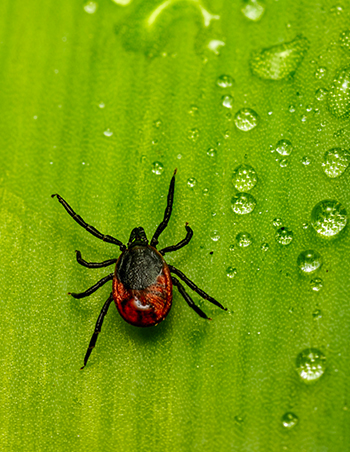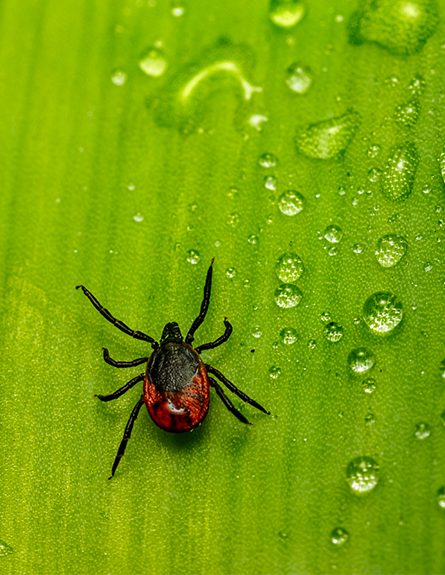
Bug Bites: Tick Prevention Tips for Spring
Date: 04/28/2023
Let’s look at how you can avoid tick bites as we get back into the full swing of hiking and camping season in 2023
As many of you may already know, I suffer from a chronic condition called Lyme disease, a vector-borne disease from tick bites that can cause chronic fatigue and immune system malfunction, among other things. It is not a disease I would wish on anyone, and yet every year anywhere from 20 to 30 thousand people in the US contract Lyme through tick bites. Some estimates put that number much higher, at about 400 thousand per year, which has me motivated to share a warning with you: tick bites can happen to anyone, and if you’re not careful, a tick bite can progress to Lyme disease and wreak very real havoc on your daily life. Tick bites are also known to spur other diseases such as ehrlichiosis, Rocky Mountain spotted fever, and tularemia.
So how can we do our best to prevent tick bites from occurring, and what should we do if we do get a tick bite?
That’s what I want to talk about today, in an effort to reduce these numbers and prevent others from suffering the major health setbacks I have experienced since being diagnosed. If we all take greater care to check for bites, wear the right clothing, and to know where ticks are prevalent to avoid those areas where possible, we can avoid tick bites and their long-term effects. But first, let’s get familiar with the different types of ticks, and where they are common to the US.
Common Tick Types in the United States & Locations
While ticks come in many shapes and sizes around the world, in the United States there are three main types of ticks that bite humans and animals–even our pets. The first type of tick is the Deer Tick, which is the type of tick most commonly associated with conditions like Lyme. This tick is known to appear in the upper midwest and easterly regions of the United States. Next is the Dog Tick, also found in the eastern US, which is more commonly known to cause Rocky Mountain spotted fever and tularemia–though dog ticks have been found as close to the Pacific as California. The last is the Lone Star Tick, which is known more to the northern and midwest US, and is more prone to cause ehrlichiosis. That being said, there are more ticks known to the US, and while they cases of Lyme are (for instance) not as prevalent in the northwestern regions, it can be assumed that care should be taken to avoid ticks no matter where you are in the country. Plus there are online maps that you can use to determine tick activity in your region for a little extra prevention protection. Just remember: while tick exposure can happen at any time of year (yes, even winter-time), ticks are more active during the warmer months of the year, like from April to September, and they are mostly found in shrubby, bushy areas.
Now that you know what kinds of ticks are out there, and where to find them, it’s time to learn the best ways to avoid getting tick bites.
How Can I Prevent Tick Bites?
You might think that just because you’re not big into the outdoors, you’re safe from tick bites; but the reality is that tick bites can happen anywhere, even in your own yard! As one source mentions:
“Ticks live in grassy, brushy, or wooded areas, or even on animals. Spending time outside walking your dog, camping, gardening, or hunting could bring you in close contact with ticks. Many people get ticks in their own yard or neighborhood.”
I say (or rather, repeat) this, not to make you become overly tick-phobic, but to ensure you’re staying careful and always doing tick checks when necessary.
Actually, tick checks are a great way to prevent a tick bite from leading to a dangerous disease or infection. That means knowing where ticks commonly bite, and how to do a thorough tick check on yourself or someone you love. Because common sites for tick bites are in your armpits, scalp, hairlines, bellybutton, behind the knees, back, or buttocks (where you’re most likely to come into contact with the ground), physical inspections should start there. Common advice is to make sure you’re not just looking for ticks either, but actually physically feeling around for ticks since they can be rather small and are often hidden. Use a mirror to help, and keep your eyes peeled for small black pin-points or feel for bumps. I also recommend checking again a few days later to make sure you’re not seeing any enlarged ticks or red-ringed spots, which can often indicate the site of a tick bite.
That being said, there are other ways to go about preventing tick bites before they even occur, and the steps you can take to avoid a detrimental disease are rather simple when you think of the risks involved in getting a tick-borne illness. Here is a short list of tick bite prevention tips that you can practice anytime you’re going to be exposed and in the outdoors for longer periods of time:
- Wear light-colored, protective clothing. That way you have a better chance of seeing ticks on your clothes, and brushing them off before they come into contact with your skin. If you do find one, I recommend killing it then and there so it can’t harm anyone else in the vicinity!
- Tuck your pants into your socks. Ticks love an exposed ankle; it gives them full access to the soft spots behind your knees, or further up to your buttocks. By tucking your pants into your socks, there is far less chance to give ticks access to your skin.
- Use a repellent with ingredients such as picaridin, or permethrin. Read ingredients labels, look for the EPA’s insect repellents icon, or visit your local outback store and they’ll definitely point you in the right direction. Permethrin is best since you can spray hiking and camping gear as well, and it’s likely to stick around and remain protective after several rounds in the washing machine. You can even buy permethrin-treated clothing!
- Avoid wooded and brushy areas with high grass or lots of old leaf coverage on the ground. Experts also recommend keeping to the center of trails and avoiding brushing through heavy tree cover.
Then, when you get back home from your hike, you can always do your tick checks while tumble drying your clothes on high heat for 10 to 20 minutes, which is hot enough to kill ticks. Note that only hot water will kill ticks if clothing needs to be washed before drying. You might not want to scald yourself in the shower with hot water, but showering after being outdoors can be an effective way to reduce your chances of getting Lyme disease specifically, just don’t forget to check your pets for ticks, too!
Oh and by the way, if you’re really worried about ticks appearing in your yard (especially important if you have kids and pets), sources say to clear tall grass, mow frequently, and to rake away dead foliage as soon as possible. You can lay gravel or wood chips down between your lawn and any forested areas to act as a barrier to prevent crossover, and keep your patio furniture and any playground equipment away from forested areas.
What Do I Do If I Get a Tick Bite?
If you notice you’ve gotten a tick bite, don’t panic: it takes time for infections to reach a person’s bloodstream from a tick bite. The sooner you take action to remove the tick, the less likely it is to push any negative, disease-causing bacteria back into your bloodstream. Indeed, it takes about 36 hours for Lyme disease to be transmitted from a tick to its host. Note however that some online sources say remedies like salt or peppermint oil can work to get rid of a tick; however, a ton of my outdoorsy friends say that the risk of the tick ‘vomiting’ its bacteria into your bloodstream as a result is high, and so I personally recommend (on their behalf) to remove the tick with a pair of handy tweezers. Here’s how to carefully remove a tick from your skin, or from your pet’s skin:
- Place the head of your tweezers close to the skin, near the head of the tick. If the tick has been attached for a while, you’ll be able to get a better grip as the tick’s body grows bigger the longer it’s attached.
- Squeeze the tweezers gently (but firmly) to get a grip on the tick’s protruding body.
- Pull the tick straight out. Do not twist the tick. Do not crush it or squeeze it either, and when you pull, ensure the head is attached to the tick, and not embedded in the skin. If the head is still embedded in the skin, you may have to do a little digging to get it out. It can be slightly painful to get the attached head, but it’s well worth avoiding the risk of disease.
- Put the tick in a piece of tissue, and squish! You might hear a popping sound. And even though it’s sort of gross, make sure to check that the tick is actually dead before throwing it away in the trash.
- Wash with soap and water. Use warm or hot water to clean your hands, as well as the area where the tick bit you.
And if you end up getting tick off of you, you can always send it for Lyme testing. There’s variety of places that can do that!
Should I Go To the Doctor if I Get a Tick Bite?
As I mentioned, early removal of a tick is key, but sometimes you may not know if you have been bitten by a tick. In a scenario where you have been bitten I would see a doctor right away with or without symptoms or bulls eye rash. The symptoms to look out for include: tiredness, headaches, fever, dizziness, rash, infection, or muscle and joint pain. Sources say the earliest and most common symptom of Lyme disease in particular is a red or pink rash that appears as a circle (or bullseye) around the site of the bite around 3 to 30 days post-infection. But many people including me didn’t have it.
I cannot express enough just how important it is to seek medical help, and to advocate for a Lyme test, even if you aren’t positive your symptoms are caused by a tick bite. I remember feeling dizzy, exhausted and having joint paint which I dismissed as being overworked. As a result of not receiving early treatment intervention, I now deal with immune and nervous system issues, chronic fatigue syndrome, and various inflammations around my joints and spinal cord. Again, I don’t wish this life upon anyone, so if you’re worried, just go get yourself checked out! It’s worth it!
Spring is Still Fun, So Enjoy It
Like I said, I didn’t write this article to make you scared to go outside–I just want you to be wary that there is a real risk involved with playing outdoors. I suspect my own tick bite came from camping out in upstate New York, and I wish so badly that I had known anything about Lyme or tick bites at the time. Part of the reason I didn’t get the right help is because I had no idea what signs or symptoms to look for, and just thought I was getting ill.
That’s why I wrote this article, so that you may become more aware of what’s out there, and what can happen if you’re not careful. And although my life is wonderful and spirited, and although I’ve gained a ton of success regardless of my illness, I know my experience is unique. I have a lifestyle that allows me to rest when I need it, and I have access to great medical care–something not everyone is so lucky to have. So, it is with my greatest hope that you continue to enjoy all the beauties the world has to offer this spring, while being just a little more careful about where you plant yourself for your next picnic or camping adventure.
Until next time, I wish you the best of happiness, and of health,
Xoxo
![]()
Lena
SUBSCRIBE
Get the latest updates, sneak peeks and more.
 Back To All Posts
Back To All Posts Previous Post
Previous Post

